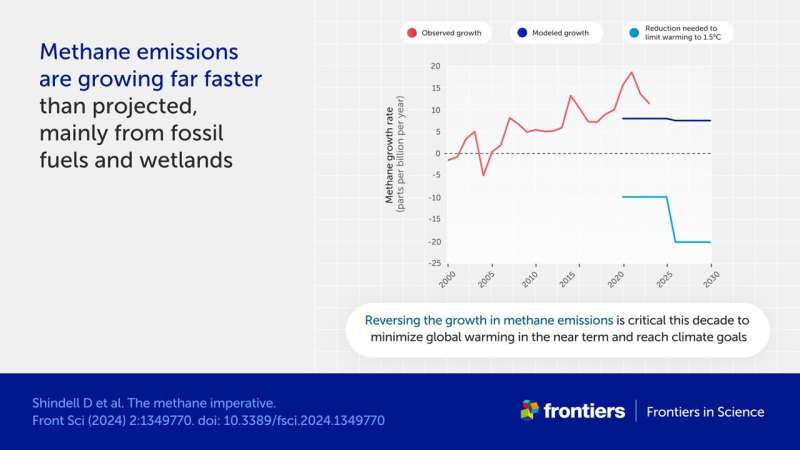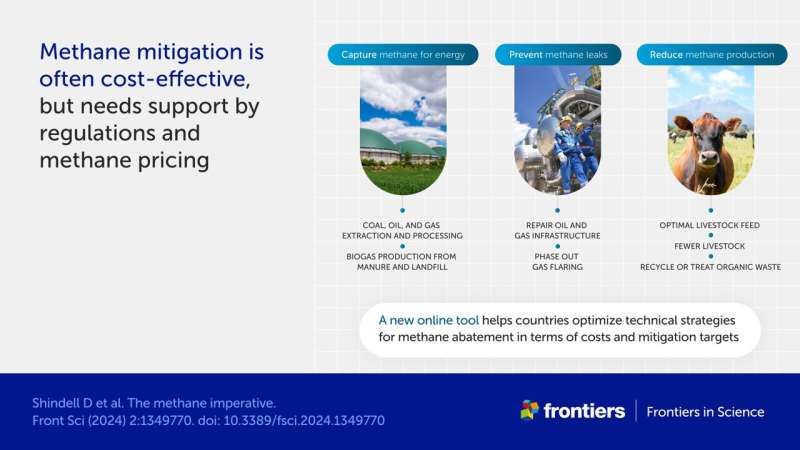This article has been reviewed according to Science X's editorial process and policies. Editors have highlighted the following attributes while ensuring the content's credibility:
fact-checked
peer-reviewed publication
trusted source
proofread
Scientists lay out three-step plan to cut overlooked methane emissions

To control the climate crisis, methane emissions must be be tackled. Methane has contributed about half the global warming experienced so far, and emissions are climbing rapidly. An international team of climate researchers writing in Frontiers in Science set out three imperatives to cut methane emissions and share a new tool to help find the most cost-effective ways of doing so.
"The world has been rightly focused on carbon dioxide, which is the largest driver of climate change to date," said Professor Drew Shindell of Duke University, lead author. "Methane seemed like something we could leave for later, but the world has warmed very rapidly over the past couple of decades, while we've failed to reduce our CO2 emissions. So that leaves us more desperate for ways to reduce the rate of warming rapidly, which methane can do."
Reduce, coordinate, and incentivize
Methane is the second most potent greenhouse gas, but only about 2% of global climate finance goes towards cutting methane emissions. These emissions are also rising fast, due to a combination of emissions from fossil fuel production and increased emissions from wetlands, driven by the climate crisis.
To slow the damage from climate change and make it possible to keep global warming below 2°C, scientists say we need to act immediately, following the Global Methane Pledge to reduce methane emissions by 30% from their 2020 level by 2030.
The scientists lay out three critical imperatives for action, backed by analyses of satellite remote sensing data, reported methane emissions, and the interaction of abatement options with market forces.
Firstly, they say, we need to bring methane emissions down. Secondly, we need to coordinate efforts to tackle methane and carbon dioxide emissions—only cutting carbon dioxide won't stop warming quickly enough, but only cutting methane just delays global heating. Thirdly, we need to incentivize and enforce methane abatement.
This is a life-saving, cost-effective measure. Estimates indicate that every ton of methane emitted in 2020 caused US$470–1,700 in damages. But this may be a significant underestimate: taking into consideration the effect on air pollution that damages human health, the true cost could be up to $7,000 per ton—and rising.

"The benefits of methane mitigation nearly always outweigh the net costs," explained Shindell. "Many methane mitigation options provide net economic gains even without accounting for environmental impacts."
Methane doesn't accumulate in the atmosphere in the long term, so emissions reductions take effect more quickly. If we could cut all methane emissions tomorrow, in 30 years more than 90% of accumulated methane—but only around 25% of carbon dioxide—would have left the atmosphere.
"The most important mitigations are the available mitigation options across all sectors that aren't too expensive, because we really need to do everything to reach climate targets such as 1.5° or 2°C warming," said Shindell. "Controlling methane from only one sector wouldn't be enough. We need a broad portfolio of actions."
The right tools for the job
The most impactful opportunities to fight methane will depend on the measures a country has already taken and the industries it relies on. So the authors created an online tool to identify the most effective measures for abatement in different countries.
For big fossil fuel producers, regulating production, incentivizing the capture of methane, or charging companies for methane emissions could be the most effective options. For others, focusing on emissions from landfills could offer the biggest rewards. Individuals can help by making lifestyle changes and by thinking about the environment when they vote.
"People can make sure they avoid overconsumption of beef and dairy, and compost their organic waste whenever possible," said Shindell.
"If it's not possible where they live, they can vote for those who'll create programs for composting in their towns. They can also vote for those who will make polluters pay for methane emissions rather than letting them profit while society picks up the tab for the damages they're inflicting."
"There are uncertainties, of course," cautioned Shindell. "We don't yet have enough data to fully parse out the contributions of individual factors to the recent surge in the observed growth rate, for example. But it is imperative to rapidly reduce methane emissions to reduce the accelerating climate damages so many people around the world are suffering."
More information: The methane imperative, Frontiers in Science (2024). DOI: 10.3389/fsci.2024.1349770 , www.frontiersin.org/journals/s … ci.2024.1349770/full
Journal information: Frontiers in Science
Provided by Frontiers



















